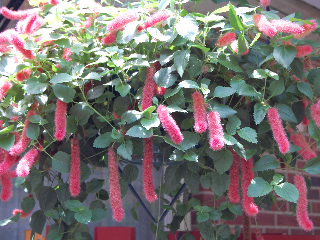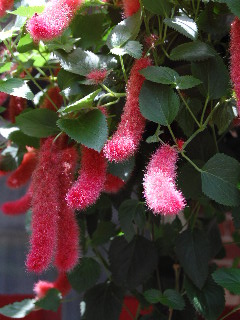
The chenille plant (Acalypha hispida) is a great addition to your houseplant collection because of its unusually shaped colorful blooms.
Those crazy blooms have led to a variety of nicknames for the chenille plant—red hot cat tail, hot dog plant, and foxtail are a few of these.
And in spite of its distinctive flowers, for purposes of our discussion in this website we’re including the chenille in our “Plants” section because that’s what it is—actually a flowering shrub that’s in the same family as the poinsettia plant.
In its native regions, the chenille shrub thrives outdoors year-round and can reach heights up to and sometimes exceeding 10 feet.
The warm season plant—it originated in the temperate regions of the South Pacific—does best, however, as a houseplant throughout the inhospitable winter months.
Then, bring it outdoors for the summer.
The chenille works perfectly as a hanging plant for your patio where the fuzzy tubular blooms can cascade around the container.
Just be sure your plant receives plenty of sunshine in order to produce the maximum number of flowers.
No special care is required in order for your chenille plant to thrive—just regular watering and fertilizing and the above-mentioned plentiful sunshine.

Possible pests are aphids or spider mites—but the plant is, for the most part, undemanding and trouble-free.
If your gardening friends want a start of your crazy-looking red hot cattail (or whatever nickname you choose to use), the chenille plant is easily propagated from cuttings.
Be aware of the plant’s toxicity to your pets, particularly if you have housecats that may be tempted to play with and chew on the hanging blossoms.
 The chenille plant (Acalypha hispida) is a great addition to your houseplant collection because of its unusually shaped colorful blooms.
The chenille plant (Acalypha hispida) is a great addition to your houseplant collection because of its unusually shaped colorful blooms.
 Possible pests are aphids or spider mites—but the plant is, for the most part, undemanding and trouble-free.
Possible pests are aphids or spider mites—but the plant is, for the most part, undemanding and trouble-free.